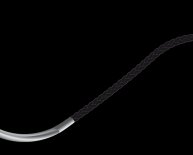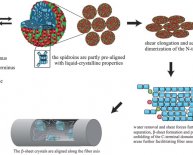
Characteristics of fibers
Different fibers have different characteristics. You may already know a lot of them just by handling them in your knitting, weaving, embroidery, or crochet. The length of a single unit of the fiber - the staple - can determine many things about the thread you will get. A short fiber is not usually a good base for thick single, whereas a long-staple can be. But a long staple fiber will sometimes not give a nice thin thread because it may become scratchy when tightly twisted into a thin thread. Slubby yarn can be great fun to work with, but the finished product may not be as sturdy as the same piece made from a uniform yarn. How much wear you get can effect what you do with the yarn. Low twist yarns are weaker, softer, lightweight, less abrasive resistant, flexible, have more loft, and pill. High twist yarns are stronger, harder, heavier, more abrasive resistant, less flexible, cooler. For example: woolen yarns - made from all lengths of the fiber (carded wool) is usually spun in a low twist yarn. Worsted yarns were spun from the long fibers only (combed into top with fibers parallel) into a high twist yarn that is usually denser and smoother, making a cooler, but wind resistant fabric. The sett or gauge in the work up of the piece also determines a lot and in figuring the gauge or sett, you sometimes need to look at the yarn. A low twist yarn woven tightly sett or knitted on a close gauge will give a more sturdy and long lasting piece than a low twist yarn worked up loosely.
Abrasion resistance - the ability to withstand wear from repeated rubbing. From good to poor: nylon, linen, acrylic, cotton, wool (coarse), silk, wool (fine), rayon, acetate.
Absorbency - comfort of a garment can be greatly affected by the fiber's ability to regain moisture. If a fiber cannot absorb moisture, it feels clammy, and can plaster itself to your skin. Absorbent fibers have less static cling. All natural fibers normally contain 10% or more water, and some can absorb up to 30% of their weight in water and feel dry to the touch. Synthetic have little or no absorbency (although, several of them do absorb oil). - from best: wool, flax, hemp, silk, cotton, ramie, nylon, acrylic, polyester.
Chemical, mildew & moth resistance - ph levels in your cleaning and dyeing baths can damage some of your fibers. Below 7 is acid, and above 7 is alkaline. Wool is resistant to acids. Silk is resistant to organic acids but damaged by mineral acids. Cellulose fibers are harmed by acids - even vinegar can do some damage. Alkaline solutions can also damage protein fibers, but cellulose fibers are more resistant. Use mild detergents to wash yarns, and fibers, remember that the minerals in your water (if you have hard water) can also do a number on your fibers. When washing protein fibers, a little vinegar (1T per qt of water) in the NEXT-TO-LAST rinse water will neutralize any alkaline residue. Chlorine bleaches will not damage cellulose fibers if used properly (according to directions), but should never be used on protein fibers. If you need a bleach for protein fibers, peroxide is sometime used - remember what it can do to your hair. The moth attacks wool, hair, fur, down & feathers of animals. Carpet beetles eat protein fiber including silk, and silverfish will eat cotton. I use lavender, bay, eucalyptus, basil, pennyroyal, tansy, cedar, or rosemary. These do not kill, only keep at bay the insects. Careful cleaning and hopefully, continual turnover will keep your place more free of pests than any moth repellants. Cellulose fibers can suffer from mildew damage; it weakens and stains the fibers. You can bleach them after a careful washing.
Elasticity - all fibers can be stretched - but they do not all have the same breaking point or the ability to recover from the stretch. The ability to recover from the stretched state is important when planning a project - clothing needs that to return to its original shape after the normal wear, but dimensional stability may be needed in other products. Recovery may not always be immediate and the time held under tension also affects its ability. Higher percentage of recovery to lower: wool, silk, rayon, cotton, ramie, flax/linen.
Flammability - wool offers the greatest resistance to fire, and other protein fibers are usually self-extinguishing. Cellulose fibers continue to glow after they are removed from the flame. Synthetic fibers vary, but range from acrylic that is so hot that it can ignite a combustible material if it drips on it, and others that have vinyl cyanide or vinyl chloride whose fumes are toxic.
Heat sensitivity - meaning wet & dry heat. Silk, wool and all protein fibers should never be boiled, simmering is the best for washing & dyeing. Cotton, linen, and other cellulose fibers are quite heat resistant and can be boiled safely.

















